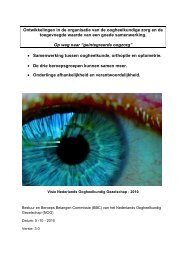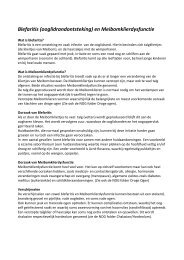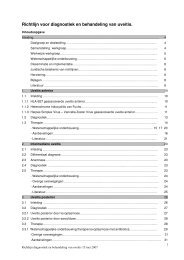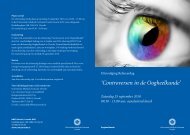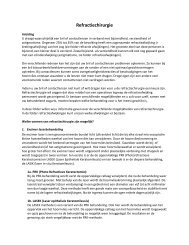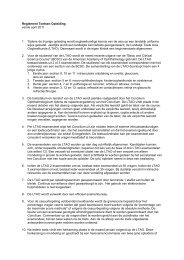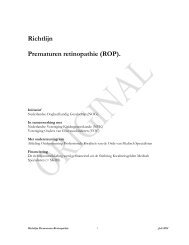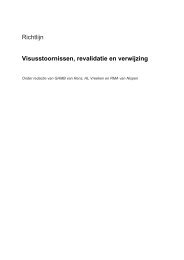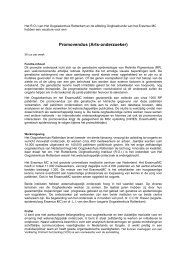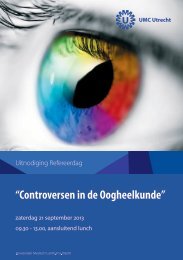terminology and guidelines for glaucoma ii - Kwaliteitskoepel
terminology and guidelines for glaucoma ii - Kwaliteitskoepel
terminology and guidelines for glaucoma ii - Kwaliteitskoepel
Create successful ePaper yourself
Turn your PDF publications into a flip-book with our unique Google optimized e-Paper software.
• Withdrawal of aqueous from vitreous body <strong>and</strong> posterior chamber<br />
Hyperosmotics are the most effective agents 5 . The patients must be evaluated <strong>for</strong> heart or kidney disease because<br />
hyperosmotics increase blood volume which increases the load on the heart. Some may alter glucose blood levels<br />
<strong>and</strong> should not be given to diabetics (see FC X).<br />
- Glycerol 1.0 - 1.5 g/Kg orally<br />
- Mannitol 1.0 - 1.5 g/Kg intravenously<br />
• Pupillary constriction<br />
- pilocarpine 1% or 2% or aceclidine 2% twice or three times within 1 hour<br />
Note:<br />
while the sphincter is ischaemic <strong>and</strong> the pupil non-reactive to light [sphincter paresis], multiple application of parasympathomimetics<br />
is not helpful, will not cause pupillary constriction <strong>and</strong> may cause <strong>for</strong>ward rotation of the ciliary<br />
muscle, thereby increasing the pupillary block. Miotics in large doses can cause systemic side effects since they are<br />
absorbed transnasally <strong>and</strong> can cause abdominal cramps. It is now recognised that intensive parasimpathomimetic are<br />
no longer indicated to treat this condition. Miotics will constrict the pupil only after IOP has been lowered.<br />
- dapiprazole 0.5% (Glamidolo, Remydrial, RevEyes) or thymoxamine 0.5%. These are alpha-1 blockers that<br />
relax the dilator muscle. They do not reduce pupil size when the sphincter-muscle is paretic.<br />
Surgical treatment<br />
- Neodymium YAG laser iridotomy.<br />
Laser iridotomy should be attempted if the cornea is sufficiently clear. Some <strong>glaucoma</strong>tologists prefer surgical iridectomy<br />
in all cases of manifest angle-closure <strong>glaucoma</strong> <strong>and</strong> use laser iridotomy only as prophylactic treatment of the<br />
contralateral eye <strong>and</strong> in cases of ‘occludable angle’. Argon laser iridotomy is rarely per<strong>for</strong>med nowdays.<br />
- Surgical iridectomy<br />
1) Transcorneal approach.<br />
Advantages: no conjunctival scarring<br />
a water-tight self-sealing incision is possible.<br />
Disadvantages: technically more difficult in dilated fixed pupil <strong>and</strong> flat anterior chamber.<br />
2) Corneoscleral approach.<br />
Advantages: iridectomy can be ‘basal’.<br />
Disadvantages: conjunctival wound may lead to scarring compromising the outcome of a filtering procedure which<br />
may become necessary at a later stage<br />
insufficient wound closure <strong>and</strong> aqueous misdirection may occur in rare cases.<br />
General advantages of surgical iridectomy:<br />
it can be per<strong>for</strong>med even when the cornea is cloudy<br />
it allows deepening of the anterior chamber, breaking freshly <strong>for</strong>med PAS.<br />
General disadvantages of surgical iridectomy:<br />
all the potential risks of any intraocular procedure.<br />
4.4.1.2 - Intermittent Angle-Closure Glaucoma (IACG)<br />
Pupillary constriction, iridotomy, iridoplasty or lens extraction are to be considered according to the main mechanism<br />
determining angle occlusion.<br />
4.4.1.3 - Chronic angle-closure <strong>glaucoma</strong><br />
Medical treatment rarely effective<br />
If the synechial closure is less than half the circumference, iridectomy/iridotomy may be sufficient. Since complications<br />
of iridectomy/iridotomy are uncommon, its use as the initial procedure is justified in practically every case.<br />
Ch. 4 - 10 EGS



